A Study on the Thermodynamic Response of Double-Armed Thin-Walled Piers under an FRP Anti-Collision Floating Pontoon Fire
Abstract
1. Introduction
2. Engineering Application
2.1. Design of Collision Avoidance Scheme of Main Pier of Continuous Rigid-Frame Bridge
2.2. The Scene Inspection of the FRP Anti-Collision Floating Pontoon
2.3. Post-Fire Damage to Bridge Piers
3. Simulation of Fire Scene for FRP Anti-Collision Floating Pontoon
3.1. Numerical Simulation Verification of FDS
3.2. CFD Calculation Model for Fire Combustion
3.3. The Transient Temperature Distribution of the Fire Space
4. The Thermal Characteristics and Mechanical Response of the Bridge Pier under Fire
4.1. The Thermal–Structural Coupling Calculation Model of the Bridge Pier
4.2. The Thermodynamic Response Analysis of the Bridge Pier
5. Conclusions
Author Contributions
Funding
Data Availability Statement
Conflicts of Interest
References
- Fang, H.; Yao, P.F.; Shen, K.J.; Jia, E.S.; Dai, Z.W. Impact tests of multistage energy dissipation and collision protection device of combined floating steel pontoon and soft object. Bridge Constr. 2022, 52, 38–44. [Google Scholar]
- Fang, H.; Wang, J.; Zhu, L.; Liu, W.Q. Study of collision protection devices for central pylon pier of Yingwuzhou Changjiang River Bridge in Wuhan. Bridge Constr. 2020, 50, 20–25. [Google Scholar]
- Wang, F.; Lv, Z.D.; Zhao, Z.; Wang, Y.G. Research on flexible anti-collision device for bridges based on rigid-flexible matching. Bridge Constr. 2021, 51, 82–87. [Google Scholar]
- Chen, W.; Geng, B.; Shen, R.L. Study on anti-collision performance of rotary cylinder typed steel composite pontooned cofferdam. J. Disaster Prev. Mitig. Eng. 2020, 40, 936–944. [Google Scholar]
- Zheng, Z.; Geng, B.; Yuan, P.; Shang, J.N.; Wei, S.S.; Hu, Z.T. Reliability of butterfly type connection structure of bridge pier FRP composite anti-collision sleeve pontoon. J. Vib. Shock 2020, 39, 281–288. [Google Scholar]
- Zhang, G.; Zhao, X.; Song, C.; Li, X.; Tang, C.; Wan, H.; Lu, Z.; Ding, Y. Review on bridge fire science and safety guarantee technology. J. Traffic Transp. Eng. 2023, 23, 94–113. [Google Scholar]
- Ozturk, B.; Yilmaz, C. Analytical Investigation of Effect of Retrofit Application using FRP on Seismic Behavior of a Monumental Building at Historical Cappadocia Region of Turkey. In Proceedings of the 9th U.S. National and 10th Canadian Conference on Earthquake Engineering, Toronto, ON, Canada, 25–29 July 2010. [Google Scholar]
- Ozturk, B.; Yilmaz, C.; Senturk, T. Effect of frp retrofitting application on seismic behavior of a historical building at nigde, turkey. In Proceedings of the 14th European Conference on Earthquake Engineering, Ohrid, North Macedonia, 30 August–3 September 2010. [Google Scholar]
- Zhang, G.; Tang, C.; Li, X.; Zhao, X.; Lu, Z.; Song, C. Fire resistance of steel truss-concrete composite bridge girder. J. Build. Struct. 2023, 44, 214–226. [Google Scholar]
- Zheng, X.L.; Jian, J.S.; Liu, L.; Sun, B.T.; Zhang, K.X.; Gao, H.S. Static and Dynamic Performance Analysis of Cable-Stayed Bridges with Cables Damaged Fire. Buildings 2024, 14, 884. [Google Scholar] [CrossRef]
- Zhang, G.; Song, C.J.; Li, X.Y.; Tang, C.H.; Wan, H. Experimental study on failure of steel-concrete composite bridge girders under hydrocarbon fire exposure conditions. China J. Highw. Transp. 2022, 35, 135–146. [Google Scholar]
- Du, Y.; Sun, Y.K.; Jiang, J.; Li, G.Q. Effect of cavity radiation on transient temperature distribution in steel cables under ISO834 fire. Fire Saf. J. 2019, 104, 79–89. [Google Scholar] [CrossRef]
- Kang, J.T.; Wang, W. Analysis of structural performance of long-span steel trussed arch bridge exposed to fire. J. Harbin Inst. Technol. 2020, 52, 77–84. [Google Scholar]
- Zheng, W.Z.; Hou, X.M.; Shi, D.S.; Xu, M.X. Experimental study on concrete spalling in prestressed slabs subjected to fire. Fire Saf. J. 2010, 45, 283–297. [Google Scholar] [CrossRef]
- Jiang, Y. Experimental and simulation study on combustion and heat spread characteristics of methanol gasoline. Hunan Univ. Sci. Technol. 2021. [Google Scholar] [CrossRef]
- Aziz, E.M.; Kodur, V.K.; Glassman, J.D.; Moreyra Garlock, M.E. Behavior of steel bridge girders under fire conditions. J. Constr. Steel Res. 2015, 106, 11–22. [Google Scholar] [CrossRef]
- Chen, Y.G.; He, H.Z.; Liu, Z.Q. Experimental study on combustion of flexible polyurethane foam under different ignition modes. J. Saf. Sci. Technol. 2022, 18, 156–161. [Google Scholar]
- Kim, H.J.; Lilley, D.G. Heat Release Rates of Burning Items in Fires. J. Propuls. Power 2002, 18, 866–870. [Google Scholar] [CrossRef]
- Lv, X.T.; Zhang, T.; Wang, W.W.; Zhang, Y.Z. Fire resistance of rectangular hollow sections steel columns filled with bar-reinforced concrete being exposure to adjacent-two-side fire. J. Liaoning Tech. Univ. 2014, 3, 346–349. [Google Scholar]
- BS EN 1993-1-2:2005; Eurocode3 Design of Steel Structures (Part1/2), General Rules-Structural Fire Design. European Committee for Standardization: Brussels, Belgium, 2005.
- Chen, W.; Shen, R.L.; Gong, W.; Hou, S.Y.; Xue, S.L. Study on fire resistance of H-shaped steel-concrete composite beams. J. Disaster Prev. Mitig. Eng. 2021, 41, 960–967+1000. [Google Scholar]

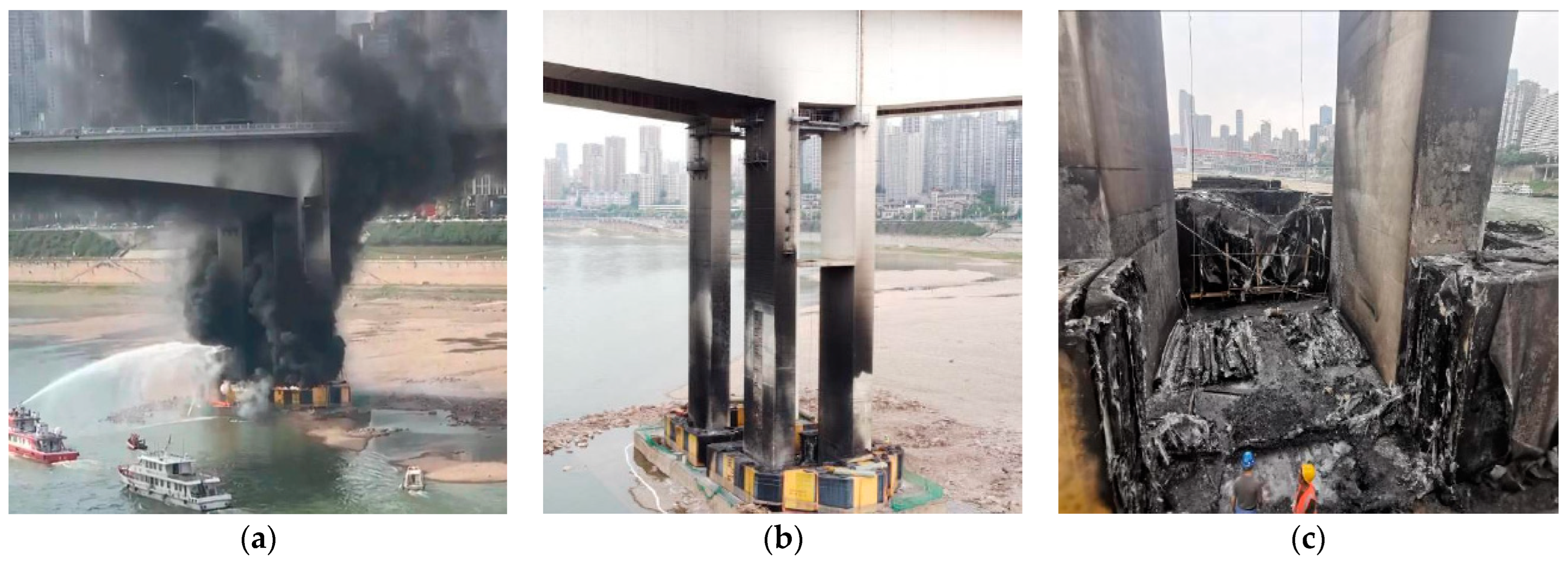
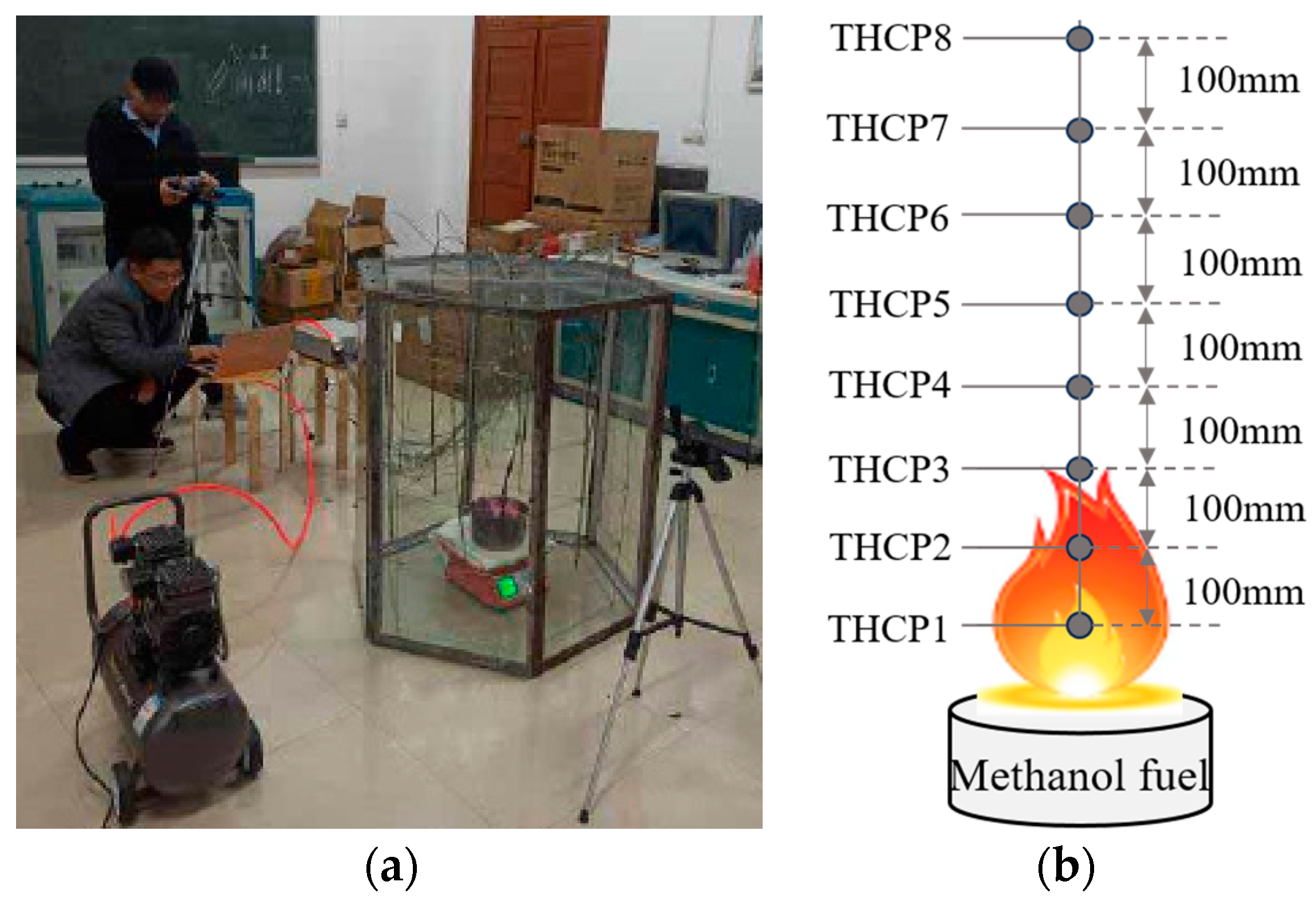





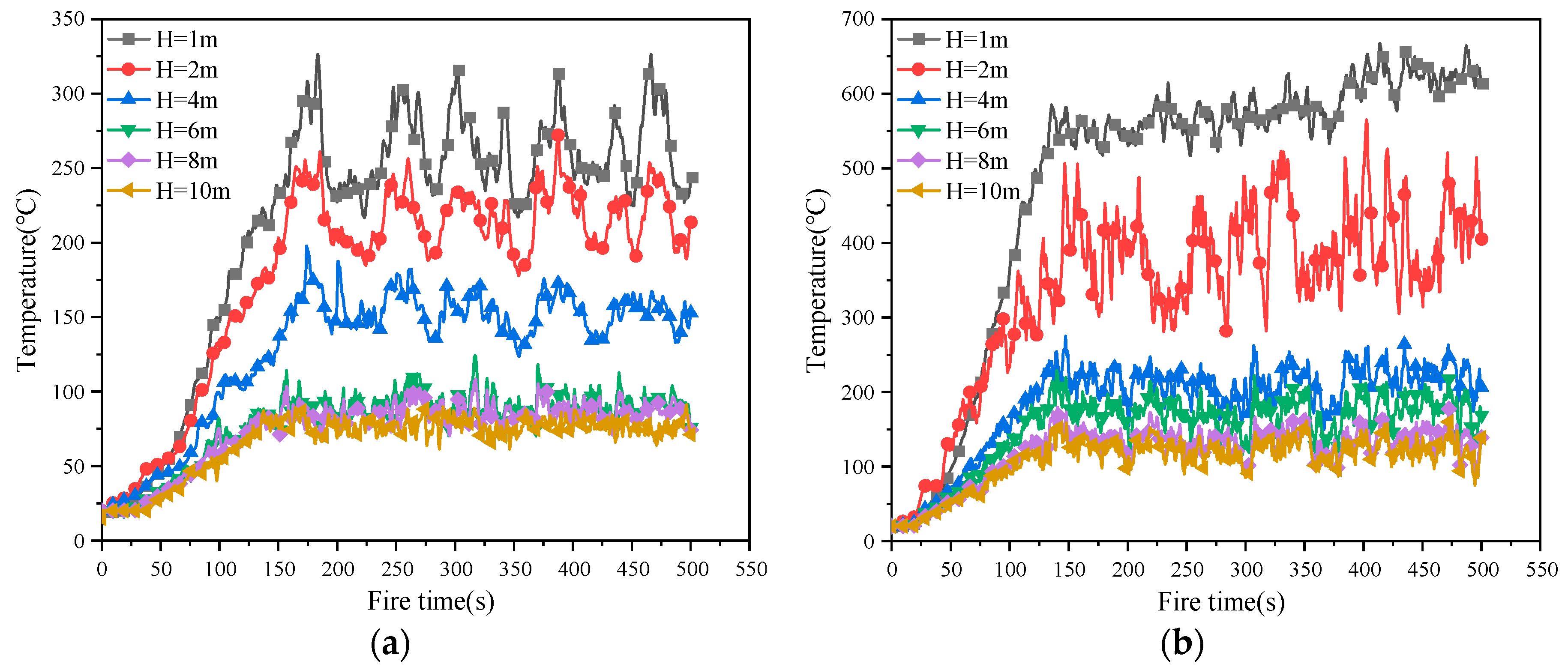

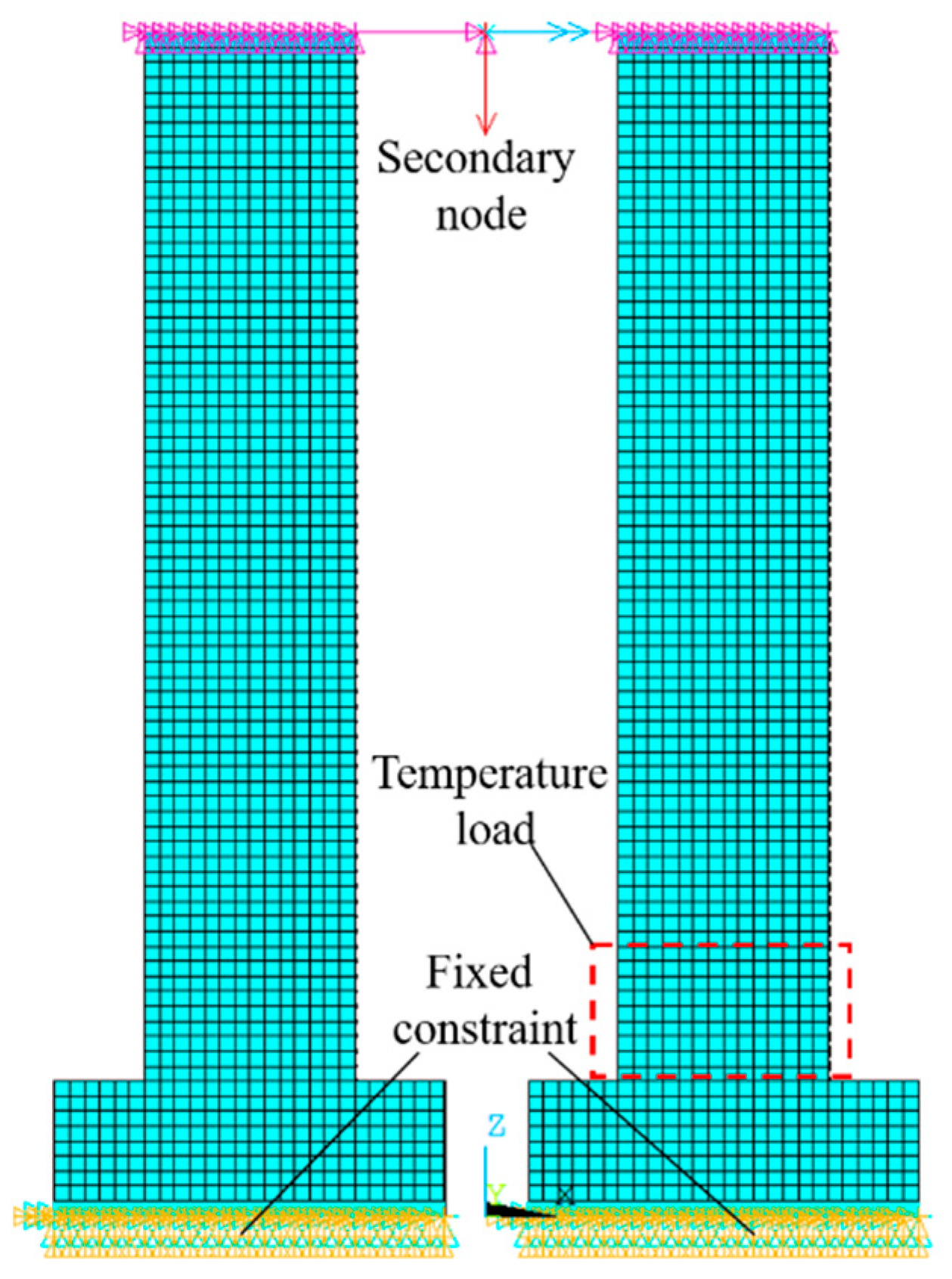
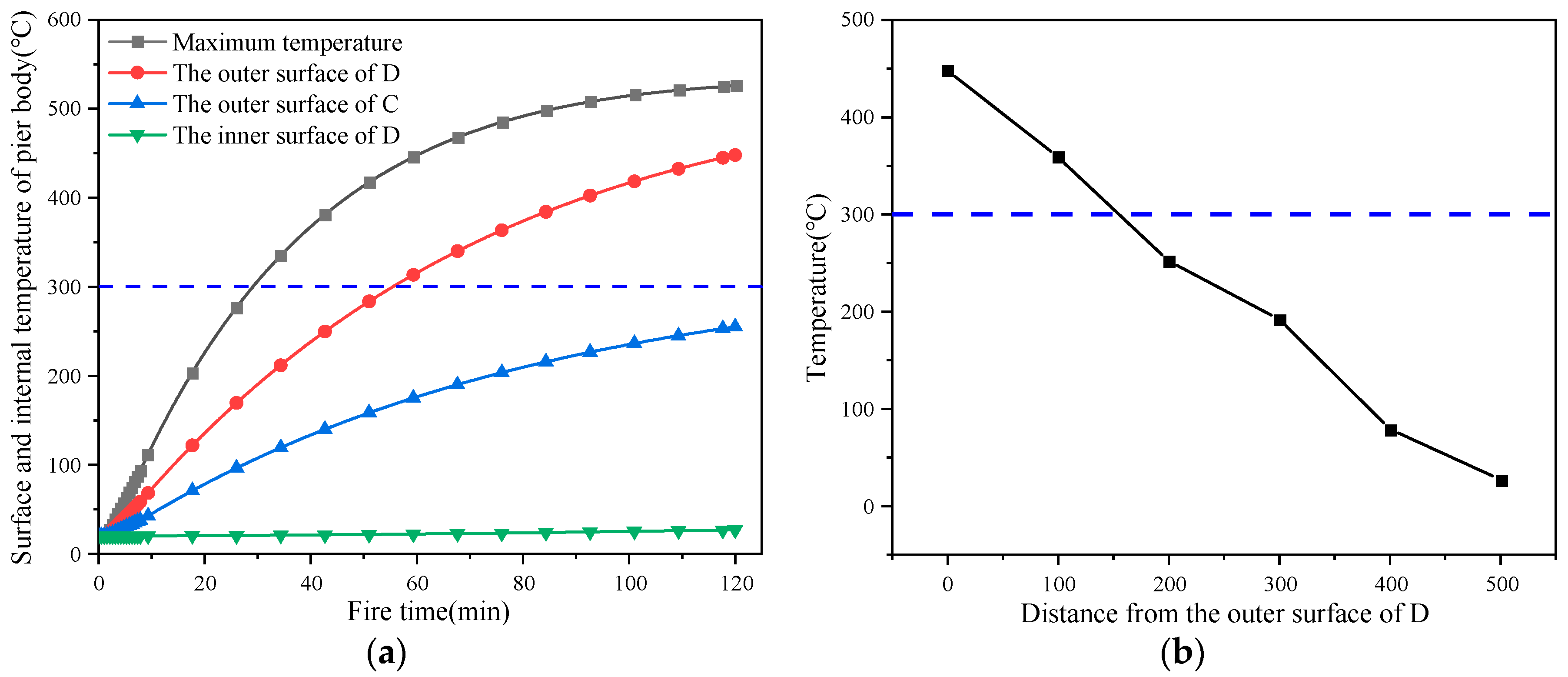
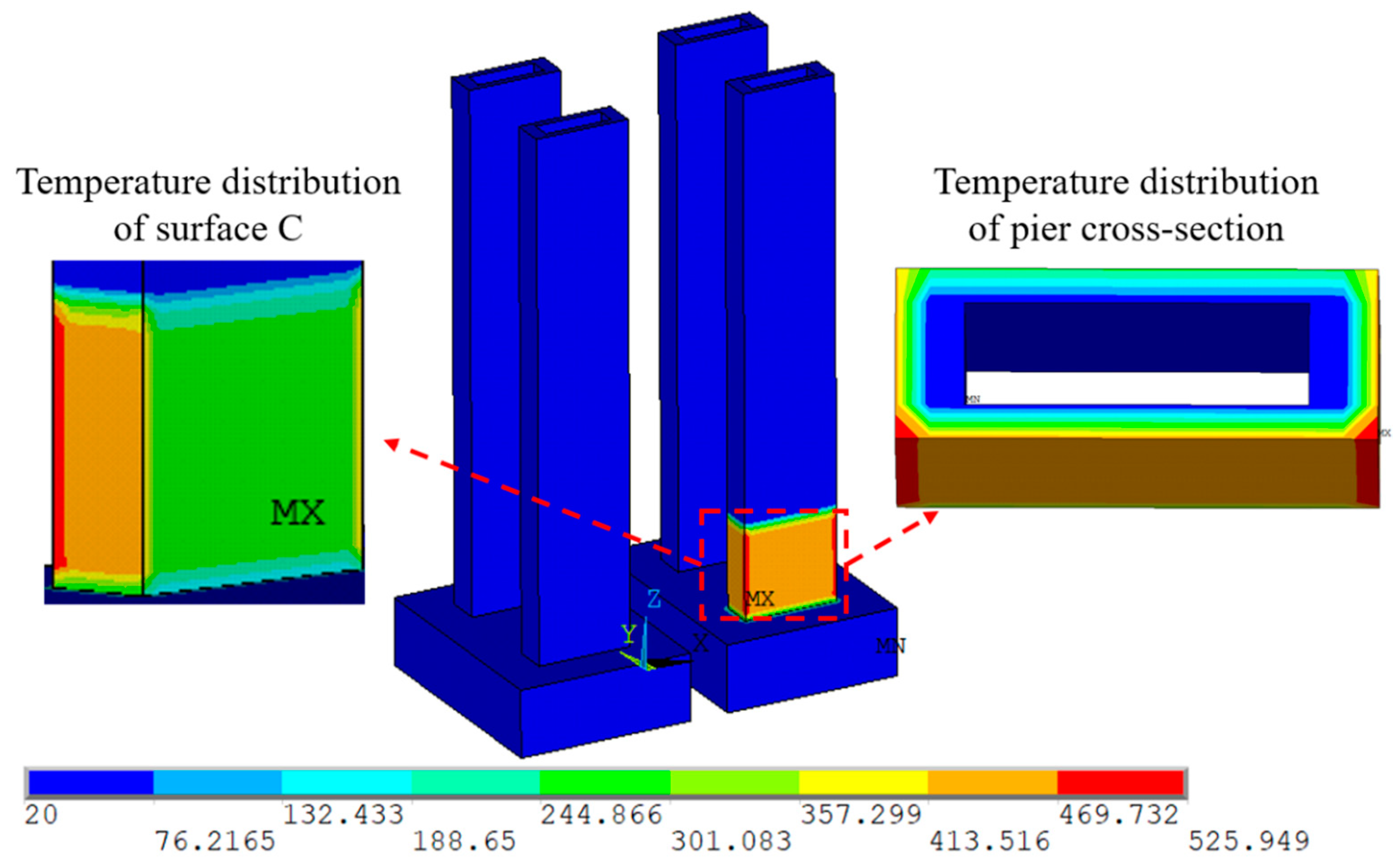
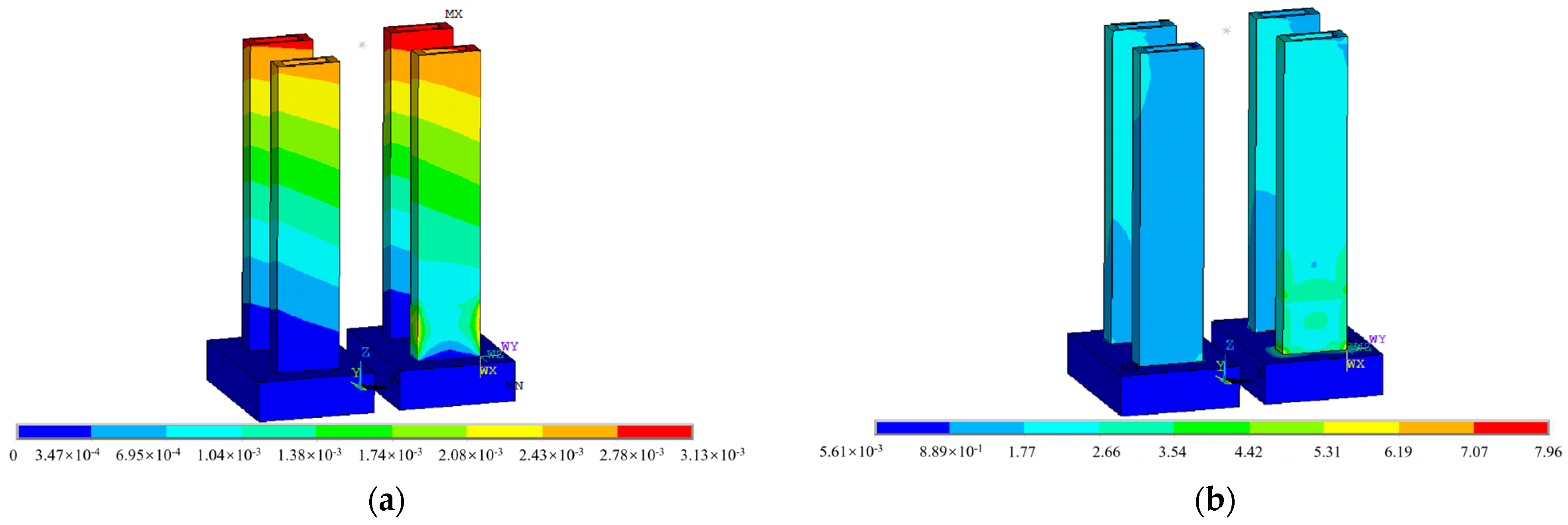
| Pier Number | Detection Position | Concrete Carbonation Depth at Different Locations (mm) | Concrete Spalling Thickness (mm) | Concrete Damage Thickness (mm) | |||
|---|---|---|---|---|---|---|---|
| 1 | 2 | 3 | |||||
| P2-1 | A | 2.00 | 1.75 | 2.00 | 1.92 | 30.00 | 84.58 |
| B | 1.75 | 0.75 | 1.00 | 1.17 | 55.00 | ||
| C | 1.00 | 0.75 | 1.25 | 1.00 | 30.00 | ||
| D | 0.50 | 0.50 | 0.75 | 0.58 | 84.00 | ||
| P2-2 | A | 3.00 | 3.25 | 3.00 | 3.08 | 28.00 | 35.00 |
| B | 2.75 | 3.25 | 3.00 | 3.00 | 28.00 | ||
| C | 4.75 | 5.00 | 5.25 | 5.00 | 30.00 | ||
| D | 0 | 0 | 0 | 0 | 0 | ||
| P2-3 | A | 2.50 | 1.50 | 2.50 | 2.17 | 0 | 80.58 |
| B | 2.00 | 1.75 | 2.00 | 1.92 | 40.00 | ||
| C | 0 | 0 | 0 | 0 | 0 | ||
| D | 0.75 | 0.50 | 0.50 | 0.58 | 80.00 | ||
| Parameter | Convection Coefficient W/(m2·°C) | Emissivity | Specific Heat Capacity | Conduction Coefficient | Thermal Expansion Coefficient | Stress–Strain | Elastic Modulus | Poisson’s Ratio |
|---|---|---|---|---|---|---|---|---|
| Value | 50 | 0.7 | Lie | Lie | Lie | EC4 | EC4 | 0.17 |
| Fire State | Pier’s Top | Pier’s Bottom | ||||||
|---|---|---|---|---|---|---|---|---|
| X (mm) | Y (mm) | Z (mm) | σ (MPa) | X (mm) | Y (mm) | Z (mm) | σ (MPa) | |
| Before fire | 1.47 | 0 | 2.62 | 1.93 | 0 | 0 | 0 | 3.01 |
| After fire | 1.47 | 1.84 | 1.71 | 1.95 | 0.13 | 0 | 0.07 | 7.96 |
| Increment | 0 | 1.84 | −0.91 | 0.02 | 0.13 | 0 | 0.07 | 4.95 |
Disclaimer/Publisher’s Note: The statements, opinions and data contained in all publications are solely those of the individual author(s) and contributor(s) and not of MDPI and/or the editor(s). MDPI and/or the editor(s) disclaim responsibility for any injury to people or property resulting from any ideas, methods, instructions or products referred to in the content. |
© 2024 by the authors. Licensee MDPI, Basel, Switzerland. This article is an open access article distributed under the terms and conditions of the Creative Commons Attribution (CC BY) license (https://creativecommons.org/licenses/by/4.0/).
Share and Cite
Zhang, Y.-K.; Yuan, P.; Geng, B.; Shang, J.-N.; Long, B. A Study on the Thermodynamic Response of Double-Armed Thin-Walled Piers under an FRP Anti-Collision Floating Pontoon Fire. Buildings 2024, 14, 1969. https://doi.org/10.3390/buildings14071969
Zhang Y-K, Yuan P, Geng B, Shang J-N, Long B. A Study on the Thermodynamic Response of Double-Armed Thin-Walled Piers under an FRP Anti-Collision Floating Pontoon Fire. Buildings. 2024; 14(7):1969. https://doi.org/10.3390/buildings14071969
Chicago/Turabian StyleZhang, Yan-Kun, Pei Yuan, Bo Geng, Jun-Nian Shang, and Bin Long. 2024. "A Study on the Thermodynamic Response of Double-Armed Thin-Walled Piers under an FRP Anti-Collision Floating Pontoon Fire" Buildings 14, no. 7: 1969. https://doi.org/10.3390/buildings14071969
APA StyleZhang, Y.-K., Yuan, P., Geng, B., Shang, J.-N., & Long, B. (2024). A Study on the Thermodynamic Response of Double-Armed Thin-Walled Piers under an FRP Anti-Collision Floating Pontoon Fire. Buildings, 14(7), 1969. https://doi.org/10.3390/buildings14071969





